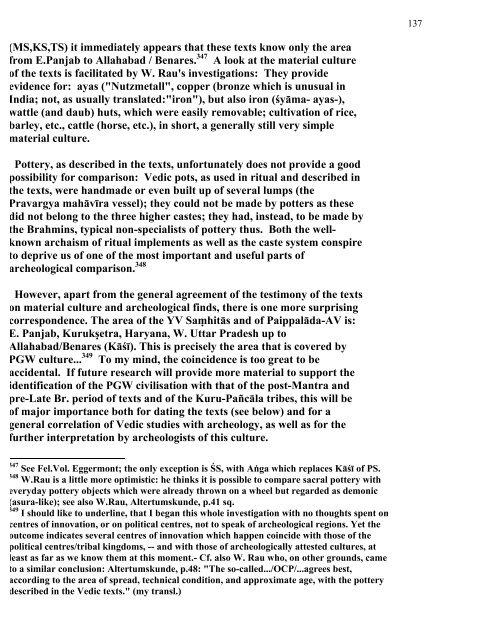TRACING VEDIC DIALECTS - People.fas.harvard.edu
TRACING VEDIC DIALECTS - People.fas.harvard.edu
TRACING VEDIC DIALECTS - People.fas.harvard.edu
You also want an ePaper? Increase the reach of your titles
YUMPU automatically turns print PDFs into web optimized ePapers that Google loves.
(MS,KS,TS) it immediately appears that these texts know only the area<br />
from E.Panjab to Allahabad / Benares. 347 A look at the material culture<br />
of the texts is facilitated by W. Rau's investigations: They provide<br />
evidence for: ayas ("Nutzmetall", copper (bronze which is unusual in<br />
India; not, as usually translated:"iron"), but also iron (śyāma- ayas-),<br />
wattle (and daub) huts, which were easily removable; cultivation of rice,<br />
barley, etc., cattle (horse, etc.), in short, a generally still very simple<br />
material culture.<br />
Pottery, as described in the texts, unfortunately does not provide a good<br />
possibility for comparison: Vedic pots, as used in ritual and described in<br />
the texts, were handmade or even built up of several lumps (the<br />
Pravargya mahāvīra vessel); they could not be made by potters as these<br />
did not belong to the three higher castes; they had, instead, to be made by<br />
the Brahmins, typical non-specialists of pottery thus. Both the wellknown<br />
archaism of ritual implements as well as the caste system conspire<br />
to deprive us of one of the most important and useful parts of<br />
archeological comparison. 348<br />
However, apart from the general agreement of the testimony of the texts<br />
on material culture and archeological finds, there is one more surprising<br />
correspondence. The area of the YV Saṃhitās and of Paippalāda-AV is:<br />
E. Panjab, Kurukṣetra, Haryana, W. Uttar Pradesh up to<br />
Allahabad/Benares (Kāśī). This is precisely the area that is covered by<br />
PGW culture... 349 To my mind, the coincidence is too great to be<br />
accidental. If future research will provide more material to support the<br />
identification of the PGW civilisation with that of the post-Mantra and<br />
pre-Late Br. period of texts and of the Kuru-Pañcāla tribes, this will be<br />
of major importance both for dating the texts (see below) and for a<br />
general correlation of Vedic studies with archeology, as well as for the<br />
further interpretation by archeologists of this culture.<br />
347 See Fel.Vol. Eggermont; the only exception is ŚS, with Aṅga which replaces Kāśī of PS.<br />
348 W.Rau is a little more optimistic: he thinks it is possible to compare sacral pottery with<br />
everyday pottery objects which were already thrown on a wheel but regarded as demonic<br />
(asura-like); see also W.Rau, Altertumskunde, p.41 sq.<br />
349 I should like to underline, that I began this whole investigation with no thoughts spent on<br />
centres of innovation, or on political centres, not to speak of archeological regions. Yet the<br />
outcome indicates several centres of innovation which happen coincide with those of the<br />
political centres/tribal kingdoms, -- and with those of archeologically attested cultures, at<br />
least as far as we know them at this moment.- Cf. also W. Rau who, on other grounds, came<br />
to a similar conclusion: Altertumskunde, p.48: "The so-called.../OCP/...agrees best,<br />
according to the area of spread, technical condition, and approximate age, with the pottery<br />
described in the Vedic texts." (my transl.)<br />
137
















